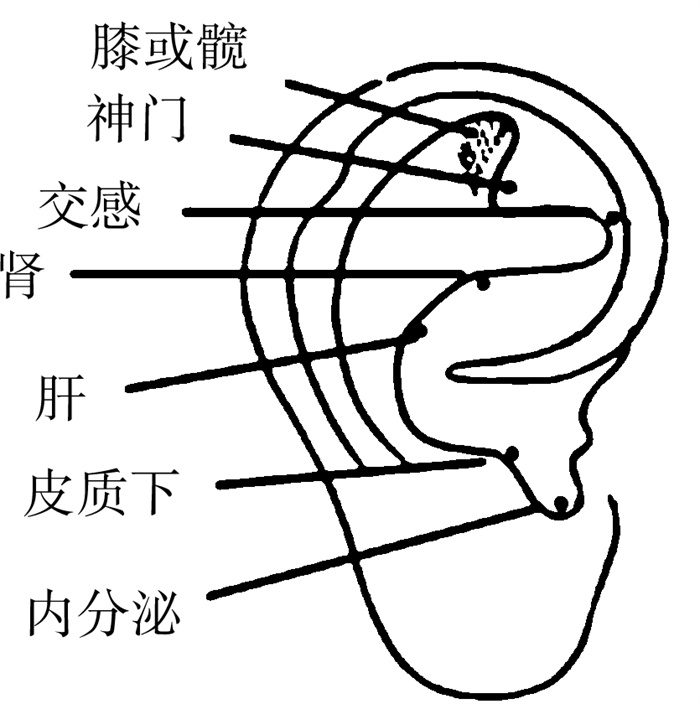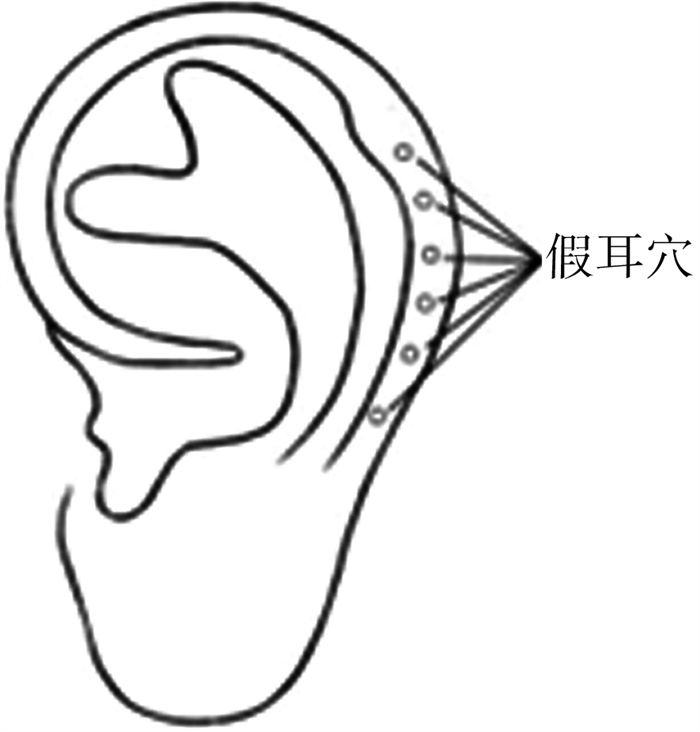加速康复外科(enhanced recovery after surgery, ERAS)是以循证医学证据为基础,通过多学科协作,优化围手术期管理,进而减少手术应激和术后并发症,促进患者快速康复。手术后多模式镇痛是ERAS的重要组成部分[1-2]。目前小儿多模式术后镇痛主要由药物和多模式镇痛方法相结合,但很多镇痛药物在小儿存在超说明书使用,导致术后镇痛药物在小儿的应用受限。同时,由于儿童不配合,术后神经阻滞持续镇痛和硬膜外术后持续镇痛在小儿开展较为困难[3-5]。耳穴疗法是一种非药物的中医治疗方法,目前已在成人不同手术中证实存在术后镇痛效果[6-7]。耳穴疗法联合阿片类药物为小儿多模式术后镇痛提供了新的思路和选择。本研究拟通过小儿骨科截骨手术后应用耳穴疗法联合舒芬太尼镇痛,为耳穴疗法在小儿多模式术后镇痛的应用提供临床证据。
资料与方法 一、研究对象本研究为前瞻性随机对照研究,以2022年6月至2022年12月在湖南省儿童医院行下肢截骨矫形手术的学龄期患儿为研究对象。患儿美国麻醉医师协会(American Society of Anesthesiologists, ASA)分级Ⅰ~Ⅱ级,通过随机数字表法分为耳穴治疗组(E组)及对照组(C组)。纳入标准:拟行下肢截骨手术;年龄6~12岁;ASA分级为Ⅰ~Ⅱ级;无心、肺、肝肾功能异常;无凝血功能障碍。排除标准:存在重要脏器及凝血功能异常;存在耳朵外观异常、耳面皮肤破溃等,不能进行耳穴帖压;硬膜外穿刺失败;既往存在慢性疼痛以及不能进行术后镇痛量表评分者。本项目通过湖南省儿童医院伦理委员会审核批准(HCHLL-2022-101),患儿监护人均知情并签署知情同意书。
样本量计算:根据前期预试验结果,两组术后CHEOPS疼痛评分分别为(6.45±1.23)分和(5.77±1.05)分,使用PASS软件计算后,a取双侧0.05,检验功效取0.9,得出每组至少需纳入45例患儿。考虑可能存在10%的失访率,本研究共纳入100例患儿,其中3例出现耳穴贴脱落,家属拒绝继续耳穴治疗而被剔除。因此,本研究共97例患儿入组,其中耳穴治疗组(E组)48例、对照组(C组)49例。
二、研究方法患儿均采取全身麻醉加气管插管复合硬膜外麻醉。术前禁食固体食物8 h,禁食牛奶6 h,禁食清亮液体2 h。入室后常规予心电监护,丙泊酚3 mg/kg、舒芬太尼0.3 μg/kg、右美托咪定0.3 μg/kg及顺阿曲库铵0.15 mg/kg快速静脉诱导。行可视下气管插管,呼吸机辅助机械通气。B超下行桡动脉穿刺置管并持续动脉测压;B超引导下行硬膜外穿刺置管,选择穿刺部位为第2至第3腰椎间隙,予0.25%罗哌卡因按0.5 mg/kg的首次负荷剂量,每隔90 min追加1/3~1/2首次剂量。予右美托咪定0.2 μg·kg-1·h-1泵入及2% ~3%七氟烷吸入,维持麻醉深度。根据脑电双频指数(electroencephalogram bispectral index, BIS)调节七氟烷浓度,维持BIS值在45~55。术中监测心率(HR)、血压(BP)、血氧饱和度(SpO2)、呼气末二氧化碳分压(PetCO2)、体温和尿量, 予静脉输注10 mL·kg-1·h-1的醋酸钠林格注射液,根据术中出血情况及血气分析结果,输注胶体或血液制品,维持收缩压在基线值的20%以内。于手术快结束缝合皮肤时,予耳穴贴压。术毕患儿带气管导管至麻醉恢复室(postanesthesia care unit, PACU)。当自主呼吸潮气量达6 mL/kg且PetCO2低于50 mmHg时,拔除气管导管。当Aldrete评分超过9分且CHEOPS评分低于6分时送回病房。两组术后均采用静脉持续镇痛(舒芬太尼2 μg/kg+100 mL生理盐水),设定负荷量为2 mL、持续输注量为2 mL/h,单次追加剂量为0.5 mL,锁定时间为15 min。
耳穴疗法:由经过耳医学培训的医师使用耳穴探测仪结合解剖学定位,找到患儿双耳的7个耳穴进行压豆操作。耳穴贴压的部位(以右耳为例):膝或髋(根据股骨或胫骨截骨部位,在图中虚线区域探测敏感耳穴点)、神门、交感、肝、肾、皮质下以及内分泌[8](图 1)。指导患儿或家属进行穴位按摩,每次按压每个穴位20~30下,每天重复3次,按压时间不限。术后出现伤口疼痛时,可以增加按压次数,以感到耳部发热和胀感为宜[9]。耳穴区胶布于术后48 h取下。空白对照组患儿于任意7个耳穴点贴上胶布,未行压豆处理,且不进行其他干预,见图 2。

|
图 1 耳穴治疗组耳穴贴压部位示意图 Fig.1 Schematic diagram of auricular point sticking sites in C group |

|
图 2 对照组耳穴贴压示意图 Fig.2 Schematic diagram of auricular point sticking sites in C group |
于耳穴贴压干预前和干预后48 h,抽取静脉血2~3 mL,通过酶联免疫吸附试验(enzyme-linked immunosorbent assay, ELISA)检测血CRP和β-EP水平。由经过培训的麻醉护士进行术后镇痛随访,分别于术后2 h(T0)、6 h(T1)、12 h(T2)、24 h(T3)和48 h(T4)评估CHEOPS评分。CHEOPS评分总分为13分,低于6分为镇痛完善;超过6分为镇痛不足,可予10 mg/kg的布洛芬静脉注射,并记录给药时间和给药次数。记录48 h内PCA按压次数及术后镇痛相关不良事件,包括术后呼吸抑制、恶心呕吐、皮肤瘙痒等。于术后48 h对镇痛效果进行满意度评分,0分表示非常不满意,10分表示非常满意。
四、统计学处理使用SPSS 26.0进行统计学分析。计量资料的正态性检验采用夏皮洛- 威尔克(Shapiro-Wilk, SW)法。对服从正态分布的计量资料采用x±s表示,组间比较采用两独立样本t检验;对于偏态分布的计量资料,以M(Q1, Q3)表示,组间比较采用非参数检验(Mann-Whitney U检验)。计数资料以频数和百分比表示,组间比较采用χ2检验或Fisher精确概率法。P值< 0.05表示差异具有统计学意义。
结果两组患儿性别、年龄、身体质量指数(body mass index, BMI)、ASA分级、手术类型、手术时间、麻醉时间及拔管时间比较,差异均无统计学意义(P>0.05)。见表 1、表 2。
| 表 1 两组下肢截骨矫形手术患儿一般情况比较 Table 1 Comparison of general profiles between two groups of children undergoing osteotomic correction for lower extremity |
|
|
| 表 2 两组下肢截骨矫形手术患儿围手术期临床资料比较 Table 2 Comparison of perioperative parameters between two groups of children undergoing osteotomic correction for lower extremity |
|
|
与C组相比,E组术后12 h和24 h静息及运动状态下CHEOPS疼痛评分较低,差异具有统计学意义(P<0.05),其余时间点两组之间差异无统计学意义(P>0.05),见表 3、表 4。
| 表 3 两组下肢截骨矫形手术患儿静息状态下不同时间点CHEOPS疼痛评分比较(x±s,分) Table 3 Comparison of CHEOPS pain scores at rest in two groups of children undergoing osteotomic correction for lower extremity at different timepoints (x±s, point) |
|
|
| 表 4 两组下肢截骨矫形手术患儿运动状态下不同时间点CHEOPS疼痛评分(x±s,分) Table 4 Comparison of CHEOPS pain scores during activity in two groups of children undergoing osteotomic correction for lower extremity at different timepoints (x±s, point) |
|
|
两组手术结束前10 min血清CRP及β-EP水平比较无统计学意义(P>0.05),手术结束后48 h血清CRP及β-EP水平差异有统计学意义(P<0.05),见表 5。
| 表 5 两组下肢截骨矫形手术患儿不同时间段血清CRP和β-EP浓度比较(x±s) Table 5 Comparison of serum concentrations of CRP andβ-EP at different timepoints in two groups of children undergoing osteotomic correction for lower extremity (x±s) |
|
|
与C组相比,E组PCA按压次数明显减少,差异有统计学意义(P<0.05)。C组布洛芬补救率高于E组,差异有统计学意义(P < 0.05)。见表 6。
| 表 6 两组下肢截骨矫形手术患儿PCA有效按压次数及布洛芬补救情况比较 Table 6 Comparison of PCA effective pressing times and ibuprofen rescue in two groups of children under- going osteotomic correction for lower extremity |
|
|
本研究共12例术后发生恶心呕吐,其中E组2例(4%)、C组10例(20%),差异有统计学意义(Z=5.9,P<0.05)。术后家属镇痛满意度评分在E组为8(8, 9)分,C组为5(5, 6)分,差异有统计学意义(Z值=-8.63,P<0.05)。
讨论小儿截骨手术涉及广泛的骨膜和骨骼组织,术后疼痛常较为剧烈,尤其是下肢截骨矫形手术,创伤大,术后疼痛尤为显著。减轻术后疼痛不仅能提高患儿舒适度,还能促进术后康复。耳穴疗法作为一种传统的中医治疗手段,在中国有着悠久的应用历史[10]。其无创、安全、简便的特点使其成为一种适合儿童疾病的治疗选择,并在多种疾病的治疗中展现出显著疗效。本研究中,耳穴疗法的使用基于耳穴的全息理论和中医的藏象学说,通过选择与手术区域相关联的耳穴来进行镇痛干预[11]。结果显示,耳穴疗法能够减轻小儿下肢截骨手术后疼痛,患儿术后12 h出现明显疼痛,予耳穴疗法干预可以明显减轻,耳穴治疗组患儿在T2和T3时间段静息和运动状态下的CHEOPS评分均明显降低,与Li等[12]研究结果一致。虽然两组在T0和T1时间段疼痛无明显区别,但不排除与硬膜外持续镇痛的效果有关[13]。2022年,Usichenko等[14]研究发现,耳穴疗法可以明显减少剖宫产术后患者镇痛药物的使用。本研究结果与其报道一致,耳穴治疗组患儿术后布洛芬的应用明显减少。
对照组由于更频繁地使用术后镇痛泵按压和布洛芬补救,在T4时间段,两组疼痛评分无显著差异,但这也导致了术后胃肠道不良反应的增加,特别是恶心呕吐发生率的增加。镇痛药物的过多使用,尤其是阿片类药物及布洛芬等非甾体类抗炎药物,容易引发胃肠道不良反应,包括恶心、呕吐和消化不良等[15]。本研究中,对照组患儿恶心呕吐的发生率近20%,而通过耳穴疗法干预能够明显降低其发生率(耳穴治疗组发生率约4%,降低近5倍),此与Chen等[16]研究结论一致。耳穴疗法的干预能够显著减少由麻醉药物引起的恶心呕吐,因此,建议将耳穴疗法作为预防术后恶心呕吐的辅助治疗方法。
目前,对于耳穴疗法的镇痛机制尚不十分明确,可能是诱发内源性镇痛途径,促进中枢内源性阿片肽β-EP的释放而产生镇痛[17-18]。本研究中,E组患儿术后48 h β-EP水平显著增加,进一步支持了这一假设。此外,E组患儿术后48 h的CRP水平显著降低,CRP是一种炎症标志物,通常用于反映术后早期炎症反应。手术创伤、炎症和疼痛均可增强患儿应激反应,而通过有效的镇痛方法,能够减少这些反应,从而降低术后并发症的发生率[19]。
然而,本研究也存在一定的局限性,虽然我们评估了患儿术后β-EP和CRP的水平,但未能进一步深入探讨耳穴疗法的具体镇痛机制。因此,未来的研究应重点关注耳穴疗法的具体生物学机制,以明确其镇痛作用原理。
耳穴疗法能够缓解小儿下肢截骨矫形手术后疼痛,减少镇痛药物的使用,减少术后恶心呕吐的发生,可以安全有效地应用于小儿围手术期管理。
利益冲突 所有作者声明不存在利益冲突
作者贡献声明 梁明超负责文献检索,梁明超、肖婷、李海霞负责论文设计,梁明超、汤可香负责数据收集,梁明超、肖婷、李海霞、杜真、屈双权负责研究结果分析与讨论,梁明超负责论文撰写;屈双权、肖婷负责全文知识性内容的审读与修正
| [1] |
Brindle M, Nelson G, Lobo DN, et al. Recommendations from the ERAS® Society for standards for the development of enhanced recovery after surgery guidelines[J]. BJS Open, 2020, 4(1): 157-163. DOI:10.1002/bjs5.50238 |
| [2] |
阮剑辉, 甘国胜, 宋晓阳. 多模式镇痛药物和技术在快速康复外科临床应用进展[J]. 广东医学, 2020, 41(23): 2402-2406. Ruan JH, Gan GS, Song XY. Advances in clinical application of multimodal analgesic drugs and techniques in rapid rehabilitation surgery[J]. Guangdong Med J, 2020, 41(23): 2402-2406. DOI:10.13820/j.cnki.gdyx.20200775 |
| [3] |
李灵晴, 肖婷, 陈政. 布洛芬注射液对于小儿拇指多指畸形手术后镇痛的效果及安全性研究[J]. 临床小儿外科杂志, 2022, 21(3): 272-277. Li LQ, Xiao T, Chen Z. Safety and efficacy of intravenous ibuprofen for pain relief in children after polydactylectomy[J]. J Clin Ped Sur, 2022, 21(3): 272-277. DOI:10.3760/cma.j.cn101785-202112013-013 |
| [4] |
Reyes CS, Carrasco ER, Martín PC, et al. Analgesia multimodal: ?se prescribe correctamente?[J]. Canarias Pediátrica, 2019, 43(1): 10-16. |
| [5] |
Heikkilä K, Peltonen LM, Salanterä S. Postoperative pain documentation in a hospital setting: a topical review[J]. Scand J Pain, 2016, 11: 77-89. DOI:10.1016/j.sjpain.2015.12.010 |
| [6] |
钟小敏. 耳穴在围手术期运用的研究进展[J]. 广州中医药大学学报, 2021, 38(3): 641-646. Zhong XM. Research advances on auricular point application during perioperative period[J]. J Guangzhou Univ Tradit Chin Med, 2021, 38(3): 641-646. DOI:10.13359/j.cnki.gzxbtcm.2021.03.037 |
| [7] |
Liu MM, Tong YG, Chai L, et al. Effects of auricular point acupressure on pain relief: a systematic review[J]. Pain Manag Nurs, 2021, 22(3): 268-280. DOI:10.1016/j.pmn.2020.07.007 |
| [8] |
中华人民共和国国家质量监督检验检疫总局, 中国国家标准化管理委员会. 耳穴名称与定位: GB/T 13734-2008[S]. 北京: 中国标准出版社, 2008. General Administration of Quality Supervision, Inspection and Quarantine of the People's Republic of China, Standardization Administration of the People's Republic of China. Nomenclatures and localizations of auricular points: GB/T 13734-2008[S]. Beijing: Standards Press of China, 2008. |
| [9] |
Zhong Q, Wang D, Bai YM, et al. Effectiveness of auricular acupressure for acute postoperative pain after surgery: a systematic review and meta-analysis[J]. Chin J Integr Med, 2019, 25(3): 225-232. DOI:10.1007/s11655-019-3063-1 |
| [10] |
Hou PW, Hsu HC, Lin YW, et al. The history, mechanism, and clinical application of auricular therapy in traditional Chinese medicine[J]. Evid Based Complement Alternat Med, 2015, 2015: 495684. DOI:10.1155/2015/495684 |
| [11] |
黄丽春. 耳穴治疗学[M]. 北京: 科学技术文献出版社, 2005. Huang LC. Auricular Acupoint Therapy[M]. Beijing: Scientific and Technical Documentation Press, 2005. |
| [12] |
Li Y, Du JL, Hao PL, et al. Effect of auricular point sticking therapy on perioperative pain in patients with partial lung resection[J]. Chin Acupunct Moxibustion, 2021, 41(6): 603-607. DOI:10.13703/j.0255-2930.20200505-k0003 |
| [13] |
杜治昆, 贾政军, 王卓, 等. 右美托咪定联合罗哌卡因竖脊肌平面阻滞在多发性肋骨骨折术后镇痛中的效果[J]. 包头医学, 2022, 46(1): 5-7. Du ZK, Jia ZJ, Wang Z, et al. Efficacy of dexmedetomidine plus ropivacaine for erector spinae plane block in postoperative analgesia of multiple rib fractures[J]. J Baotou Med, 2022, 46(1): 5-7. DOI:10.3969/j.issn.1007-3507.2022.01.003 |
| [14] |
Usichenko TI, Henkel BJ, Klausenitz C, et al. Effectiveness of acupuncture for pain control after cesarean delivery: a randomized clinical trial[J]. JAMA Netw Open, 2022, 5(2): e220517. DOI:10.1001/jamanetworkopen.2022.0517 |
| [15] |
Kovac AL. Postoperative nausea and vomiting in pediatric patients[J]. Paediatr Drugs, 2021, 23(1): 11-37. DOI:10.1007/s40272-020-00424-0 |
| [16] |
Chen JB, Tu Q, Miao S, et al. Transcutaneous electrical acupoint stimulation for preventing postoperative nausea and vomiting after general anesthesia: a meta-analysis of randomized controlled trials[J]. Int J Surg, 2020, 73: 57-64. DOI:10.1016/j.ijsu.2019.10.036 |
| [17] |
Mayor D. An exploratory review of the electroacupuncture literature: clinical applications and endorphin mechanisms[J]. Acupunct Med, 2013, 31(4): 409-415. DOI:10.1136/acupmed-2013-010324 |
| [18] |
Jin L, Yao R, Heng L, et al. Ultrasound-guided continuous thoracic paravertebral block alleviates postoperative delirium in elderly patients undergoing esophagectomy: a randomized controlled trial[J]. Medicine (Baltimore), 2020, 99(17): e19896. DOI:10.1097/MD.0000000000019896 |
| [19] |
Xi LJ, Fang F, Yuan HJ, et al. Transcutaneous electrical acupoint stimulation for postoperative cognitive dysfunction in geriatric patients with gastrointestinal tumor: a randomized controlled trial[J]. Trials, 2021, 22(1): 563. DOI:10.1186/s13063-021-05534-9 |
 2024, Vol. 23
2024, Vol. 23


